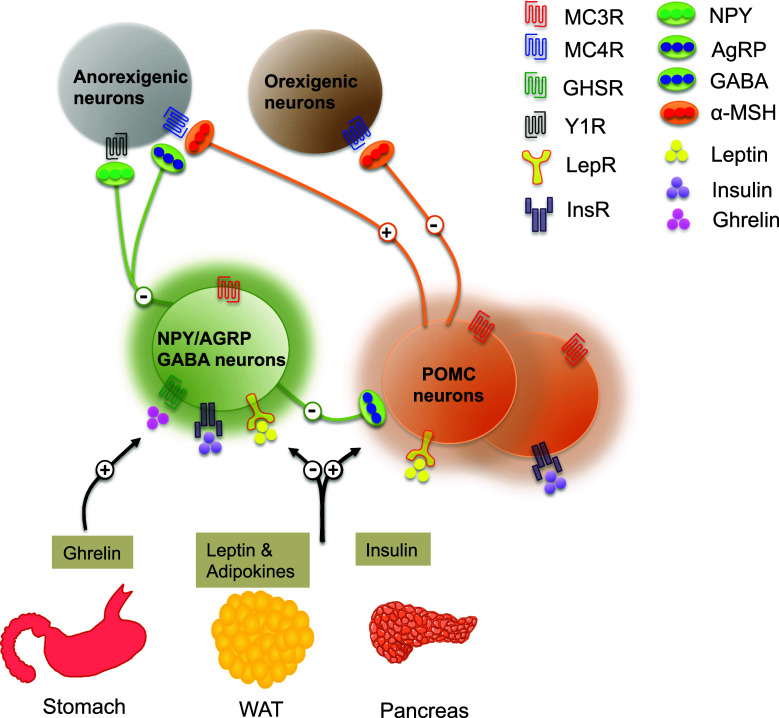Fig. 1.
Hypothalamic melanocortin pathways regulating central energy metabolism. The hypothalamic arcuate nucleus detects a variety of metabolic signals, which originate from several peripheral organs including the gut, adipose tissue and pancreas. For example, the AgRP/NPY neurons express ghrelin receptors, and, thus, specifically detect a gut-derived and hunger-related metabolic molecule, ghrelin, to facilitate energy intake. On the other hand, distinct subtypes of POMC neurons produce either leptin or insulin receptors and respond to the anorexigenic molecules such as adipose-originated leptin or pancreas-derived insulin. Notably, POMC neurons expressing leptin receptors do not co-produce insulin receptors, and vice versa, indicating the existence of heterogeneous subtypes of POMC neurons in the hypothalamus. AgRP/NPY neurons also express leptin and insulin receptors; however, these molecules negatively regulate the AgRP/NPY neuronal activity, unlike POMC cells. POMC and AgRP/NPY neurons project their axon terminals into various brain regions and activate and/or inactivate target cells expressing the dominant melanocortin receptors MC3/4R. Indeed, POMC and AgRP/NPY neurons are in functional opposition to one another. POMC neurons stimulate a satiety response by releasing α-MSH, the most well-known POMC-derived small melanocortin associated with energy balance and feeding behavior, to the anorexigenic system. AgRP/NPY neurons release AgRP and NPY, which are naturally appearing, endogenous antagonists of α-MSH, to the anorexigenic system. Furthermore, AgRP/NPY neurons also create synaptic connections with the POMC system and release GABA to inactivate this system. Overall, a precise coordination of signaling between the POMC and AgRP/NPY systems in the hypothalamus, in concert with metabolic status, is critical for balancing feeding behavior and whole-body energy homeostasis. NPY neuropeptide Y, AgRP agouti-related peptide, GABA gamma-aminobutyric acid, α-MSH α-melanocyte-stimulating hormone, MC3/4R melanocortin-3/4 receptor, GHSR growth hormone secretagogue receptor, Y1R neuropeptide Y Y1 receptor, LepR leptin receptor, InsR insulin receptor, WAT white adipose tissue

